#VR Community Management
Explore tagged Tumblr posts
Text
Meta Horizon Worlds v163:「投票移除」功能更新與修復重點介紹
我們非常想知道您對 Meta Horizon Worlds v163 更新中新功能的看法!您覺得投票移除功能有助於改善社交互動嗎?請在下方留言分享您的想法,我們樂於聽取並回應每一位讀者的見解!
在最新的 v163 版本更新中,Meta Horizon Worlds 帶來了一系列提升使用者體驗的改進。這包括了一個正在測試階段的新功能,讓用戶在錄製影片或拍照時能夠切���名牌標籤的顯示與否。此外,亦新增了世界詳情頁面的內容描述符,以及對「投票移除」功能的更新,增強了用戶的操作便利性和互動體驗。 在一般改進方面,Meta 團隊加速了虛擬世界中畫廊的加載速度,使用者現在可以更快地存取及分享照片和影片。針對名牌標籤的切換功能,該功能目前處於測試階段,只對部分用戶開放。在測試階段的用戶可以在開啟相機時,透過一個新的圖標來切換名牌標籤的顯示與否。值得注意的是,使用無人機相機拍攝時,名牌標籤會自動移除,且無法切換。 Poll to…

View On WordPress
#虛擬實境#虛擬實境遊戲#虛擬實境新聞#META#Meta Horizon Worlds v163#Meta Platform Innovations#Meta Quest#Meta Quest New Features#Quest 2#Quest 3#Virtual Reality Content Guidelines#Virtual World Accessibility#vr#VR Community Management#vr game#vr news#vr news today#VR Social Features#VR user experience improvements#VR Video and Photo Tools
0 notes
Text
Captivating Audiences: The Evolution of the Digital Signage Market

In the ever-evolving landscape of marketing and communication, the Digital Signage Market has emerged as a dynamic force that's transforming the way businesses engage with their audiences. Gone are the days of static posters and traditional billboards – digital signage has taken center stage, offering a visually compelling and interactive platform for delivering messages, promotions, and information.
The Digital Signage Market encompasses a wide array of applications, spanning industries such as retail, hospitality, healthcare, education, and transportation. Its versatility lies in its ability to deliver dynamic content, including videos, images, animations, and real-time data, all of which grab attention and convey messages in a more engaging manner.
A driving force behind the growth of the Digital Signage Market is its power to enhance customer experiences. In the retail sector, for example, businesses are leveraging digital signage to create immersive and personalized shopping journeys. Interactive displays allow customers to explore products, access additional information, and even try out virtual simulations. This not only boosts customer engagement but also helps convert browsing into buying.
Furthermore, the integration of data analytics is revolutionizing the effectiveness of digital signage. Businesses can gather insights on customer behavior, preferences, and engagement patterns. This data-driven approach enables them to tailor content, delivering the right message to the right audience at the right time. This level of personalization contributes to a more meaningful interaction, fostering customer loyalty and brand affinity.
As technology continues to advance, the Digital Signage Market is experiencing innovations that push the boundaries of creativity. From curved and ultra-high-definition displays to transparent screens and holographic projections, the possibilities seem limitless. Such innovations enable businesses to create immersive environments that captivate audiences and leave lasting impressions.
However, the Digital Signage Market is not without challenges. Content management, ensuring consistency across multiple screens, and addressing security concerns are some of the hurdles that businesses must navigate. Moreover, as the market becomes more saturated, distinguishing oneself through compelling content and strategies becomes crucial for success.
In conclusion, the Digital Signage Market is revolutionizing the way businesses communicate, interact, and leave an impact on their audiences. With its versatility, interactivity, and data-driven capabilities, digital signage is playing an instrumental role in shaping modern marketing and customer engagement strategies. As technology evolves and customer expectations rise, businesses that harness the potential of the Digital Signage Market are better positioned to thrive in a digital-first world.
#Digital Signage#Market Trends#Interactive Displays#Content Management#Customer Engagement#Data Analytics#Personalization#Technology Innovation#AI Integration#Sustainability#AR/VR Experiences#Advertising Solutions#Communication Strategies#Retail Marketing#Digital Communication#Audience Targeting
1 note
·
View note
Text
Hood got the power back on and the kiddos were safety ensconced in the TV room, with something called Bluey playing. Superboy had been picking through the snacks gingerly, trying each one a tiny bit at a time. Like he had no idea what they were or what he liked. Bart inhaled anything put in front of him. Cass was snuggled up between the two but kept shooting Hood 'I'm watching you' looks. Tiny Tim was off to the side a little away form the other kids. Apparently he'd had a shy streak or something.
Either way the blue cartoon dogs were talking and Jason had to find out what was going on. And the most frustrating thing was it was his own fault it would be harder to figure out. The scrambled he'd used on the security system for his grand plan would knock out any recordings for the last few hours, to make it hard for the Batman to pinpoint anything. And consequently making it that much harder on him. At least he didn't erase communications, so their might be something there.
He checked the logs before from before the scrambler. He could see Robin and Wondergirl entering the Tower, but not Impulse or Superboy. They must have come recently. One outgoing communication, sound-based. He pulled it up.
"Batman this is Robin. A project I was working on with Wondergirl has gone south. Sabotage suspected. I may need backup."
"Are you in any immediate danger?"
"Not to my knowledge."
"I need to focus on Red Hood. Manage on your own as well as you can. I'll contact you when I'm able."
Hood leaned back. That was...almost perfect in it's own way. His whole reason for coming her was to prove his point about the dangers of putting kids in those traffic light colors (and a little revenge). But here...here was Robin asking Batman for help -and if he was like any other Robin that meant the situation was BAD- and Batman turning him away to focus on a criminal. There was a tiny part of him that hoped this was permanent and that that would be Bruce's last conversation with Robin as he knew him, Tim asking for help and Batman ignoring it. Because he knew that would absolutely eat him ali-
"Who's that?"
"JESUS!" Hood catapulted right out of his chair. He had been Bat Trained AND League trained, how did this four year old sneak up on him????
"I don't think that was Jesus," Tim said timidly.
Hood took a few calming breaths. "That was the person I came to find. Looks like he called for help half an hour ago and got turned aside." What were you and Wonder Girl up to that caused this? "What are you doing here?"
"I wanted to help ᵃⁿᵈ ⁱ ᵈᵒⁿ'ᵗ ᵗʰⁱⁿᵏ ᶜᵃˢˢⁱᵉ ˡⁱᵏᵉˢ ᵐᵉ." The last part was said almost as a whisper.
Hood pinched his nose. "Did she say something specific to you, or was she just bossy and aggressive? Cause I think that might just be her personality. Let's get you back with the others." Hood picked up Tim who let out a surprised 'Eep' and carried him back to the TV room.
He tried to put Tum on the couch with the others, but the kid clung to him like a barnacle.
"So when are our parents going to be here?" Cassie asked challengingly, her head aimed at the TV, but her eyes on Hood.
"No clue." Hood says. "And how would they even know to come here."
"You didn't call them?" she asked accusation clear in her voice.
Hood pinched his nose. "How would I call them? I have no clue who they are or what their phone numbers are?"
Cassie rolled her eyes. "415-555-4372"
"Cool," It was unlikely to work, but at least she had one. "Any for the rest of you?"
"I don't think the program had things like that. It monitored my health itself." Bart said, genuinly more focused on the show than he was on Hood.
"The program?"
"The VR Program that was raising me." Bart nodded, like that was a normal thing to say.
"I don't think I have a phone number. Or parents." Superboy mumbled.
"They didn't give me a number, cause I'm not supposed to call them." Tim said, still clinging to Hood with all his tiny might.
Annnnd Wonder Girl continues to have the one decent parent. And he knew Superboy was a clone, but he was starting to get worried about Impulse.
Hood removed his helmet, thankful he was wearing his old Robin mask underneath. No sense in scaring whoever was on the other end. A voice changer on an unknown number usually didn't lead to anything good. Especially if it was on the off chance Cassie's Mom still had the same number and he was following it up with 'I have your kid'.
He dialed the number she gave him was was only mildly surprised it got picked up. Number did get reused after all. "Hello, Helena speaking."
"My name's Red." Might as well stick with what he used for the kids. "I don't suppose this is Cassie's mother?"
"This is." Her voice filled with panic. "Oh no, please no. Not Cassie too!"
Red kicked himself as she realized what call Cassie's Mom thought she was getting. "Not that. You're daughter is a...perfectly healthy six year old."
"Six and a half." Cassie yelled over the phone.
"Is that..." Panic seemed to give way to bewilderment.
"Yes, would you like to speak with her?" Hood was more than happy to opt out of this conversation.
"Please." He handed the phone over and listened to Helena talk to her much younger daughter. And tell her ALL her suspscions baout him.
After a while Cassie handed the phone back to him. "She wants to talk to you some more." Cassie said, before sitting back to watch the show.
"Red here." and now this was going to suck.
"What the hell happened to my daughter?" Helena's voice was like ice.
"Your guess is as good as mine." Hood admitted. "I came here looking for Robin and just stumbled into the three of them trying to figure out what was wrong with Bart, because they didn't understand speedster metabolism, including the speedster."
"What do you mean, Bart?" The icyness of the tone gave way to fear. "Bart? The Speedster kid?" What could have garnered that reaction? From what little he'd known, he and Cassie had been on the same team for years.
"Bart's dead." Helena said.
Hood yanked off the barnacle named Tim and put him on the couch and moved away. He didn't want any of them overhearing this. "What do you mean dead?" He hissed.
"He died months ago. Him and Kon. Cassie hasn't been taking it well."
"Kon?" Hood felt the hairs on his neck prickle.
"Superboy. Shouldn't you know-"
"I don't know them. I needed to go over something with Robin related to Gotham." He ran his hands through his hair. "But I think you've given me my first major clue. Can you get here?"
"Absolutely." Helena said. "But I'll need someone to let me in."
"Can do." The faster he could pawn this off on someone else, the better. And right now, he just wanted to crash. While the night had come with far less physical exertion than expected, he was exhausted.
He'd driven from Gotham to San Francisco, so as to avoid being seen on any public transit. Then he'd set up an extremely complicated plan, began to execute it, and then had to stop to babysit, undoing the complicated work he'd done to get access to the Tower records- which told him nothing, and now he was back to babysitting four kids waiting for one's Mom to show up. And two of the kids were supposed to be dead. Just like him.
He'd collapsed in a chair with the cartoon dogs still going, and had almost accidentally fallen asleep when something dropped on his lap. His eyes shot open to the tiny form of the person he'd wanted to maim sitting there, apparently having climbed off the couch and up the arm of the chair.
He opened his mouth to ask why he wasn't with the other kids, but remembered he thought Cassie didn't like him. (Part of him wanted to correct that assumption, but they were going to get back to their proper selves soon enough, so why bother). The question was why he thought Hood did.
Maybe he was bullied? And he thought an adult would at least be reasonable? Hah- reasonable was never a word used to describe Jason and never would be. But...he was at least reasonable enough not to take out his ire on a preschooler that trusted him. Wait until he was back to normal and could fight back.
"Love you." Tiny Tim whispered as he curled up to sleep.
"You don't even know me." Hood said dryly.
"You gave me a hug." Tim said, as if it was that simple.
A hug? When had he...was this kid counting getting picked up as a hug? Damn, he must have short circuited when he met Dickie.
Anyway it was good Tim had stopped him from falling asleep, given the chance that all the little terrors could at any moment turn into teenage terrors that wanted to and could theoretically kick his ass.
At least until Helena came. Then he could turn over the kids and crash some where. Simple as that. Not like he was going to get involved any further.
He didn't even notice his hand resting on the sleeping child's head.
#Ghost Writing#FatherHood#Helena's on her way#And more YJ characteers will be showing up in short order#After all who know more about resurrections leading to deagings than Anita?#And they'll need some baby sitters and Cissie and Greta are happy to oblige
31 notes
·
View notes
Text
The Golden Spiral - Part 1
(A story by @midasslave1 done in collab with @polo-drone-070)
1. The Abduction
In the heart of Paris, the vibrant nightlife pulsed with energy. PDU-070 a young asian polo-drone, was observing the crowd in a nightclub, scanning for potential recruits, in the signature tight black rubber Fred Perry polos of Polo-Drones. PDU-070 felt a sense of belonging and pride as he focused on its mission, the atmosphere electric with excitement. It had managed to lure some interesting recruits that will soon be unable to resist the pull of the rubber polo.
Meanwhile, across the world in New Zealand, 35-year-old Jett, known as Waterboy 05 of the Golden Army, was preparing for a night out on the town. Clad in his shiny Liverpool F.C. football top, he felt a rush of camaraderie from his new association with the amazing online community. The Golden Army was a close-knit group, and Jett cherished the bonds he had formed.
But as the night wore on, a sinister plot was unfolding. In Paris, as PDU-070 stepped out of the nightclub, he noticed a dark van idling at the curb, its windows tinted and unmarked. A chill ran down his spine, but he brushed it off, attributing it to the late hour. Just as he turned to head home, two figures wearing full body metallic gold latex suits emerged from the shadows, their movements swift and calculated. Before he could react, they grabbed him, covering his mouth with a cloth soaked in chloroform. Once subdued but not unconscious he was fitted with a VR headset with MIDAS written on the front over his eyes. The world around him faded into darkness as he struggled against their grip and placed into the van.

Simultaneously, in New Zealand, Jett just getting home, stepped out of his car in his driveway when he heard a loud crash on the roadside. Curious, he left the safety of his premises only to be met by a dark van. The gold latex figures lunged at him, overpowering him before he could call for help. A cloth was pressed against his face, and he too succumbed to the sweet, suffocating scent of chloroform, when he was placed in the back of the van and was also fitted with a VR headset over his eyes.

2. The Glass Room
When PDU-070 and Jett awoke ,they found themselves in a stark, sterile glass room, disoriented and confused.
The walls shimmered with an unsettling golden hue, and they quickly realized they were locked with someone they didn't recognise to golden chairs by metal cuffs and leather harnesses. And now wearing a thick metallic gold collar around their throats.
Panic surged through them as they struggled against their restraints, but the more they fought, the more they felt the cold grip of fear tightening around them.
Suddenly, a voice echoed through the room, smooth and commanding. “Welcome, gentlemen. You are now part of Midas Enterprises. We have plans for you.” The voice belonged to a figure shrouded in shadows, their intentions cloaked in mystery.
New golden VR headset were placed over their eyes and the screens came to life, golden spirals began to swirl before their eyes, mesmerizing them.
The spirals pulsed with an otherworldly energy, drawing them deeper into a trance. They inhaled and exhaled a strange golden smoke that filled the room, its effects creeping into their minds like a fog.

The kidnappers explained their sinister plan to them for no particular reason but to gloat. They intend to infiltrate the Polo-Drones and the Golden Army, claiming their many members around the world to build a world-dominating force.
3. The Transformation
Days passed in a blur as PDU-070 and Jett were subjected to relentless brainwashing. They were fed misinformation about the Golden Army they both belonged to, though in different group, their loyalties twisted into obedience to Midas Enterprises. Hidden triggers were embedded deep within their minds, waiting for the right moment to activate. The golden smoke clouded their thoughts and coated the inside of their body and they began to lose sight of their true selves.

Finally, after what felt like an eternity, they were released back into their respective countries, their memories hazy and fragmented. They returned to their lives, unaware of the dark programming that had taken root within them.
TO BE CONTINUED.....
To join the Gold Army, contact one of our recruiters @brodygold, @goldenherc9 or @polo-drone-001.
#Golden Army#GoldenArmy#Golden Team#theGoldenteam#AI generated#jockification#male TF#male transformation#hypnotized#hypnotised#soccer tf#Gold#Join the golden team#Golden Opportunities#Golden Brotherhood#Polo Drone#Polodrone#PDU#Polo Drone Hive#Rubber Polo#rubberdrone#Join the Polo Drones#assimilation#conversion#drone#dronification#mind control#obeymidas#enslaved#midasenterprises
50 notes
·
View notes
Text
My opinion so far on the VR characters (that no one asked for) :
I am using the dub names, they are easier to remember
Destin Billows
Of course i am beginning with the protagonist, you can't stop me. Neither you can stop him actually ! I love how bro is 1m40 30kg and still a menace and dare argue with muscle mountains that has the entire school behind their back. He is the ultimate hater, he is sassy and judge ppl and i am all in for this. His position as manager in quite interesting for a IE protagonist, because for him to not have a passive role in game, i think they included a whole management "gotta give them bois a career" part. At first, i wasn't a fan of him because of his design but once i saw how he gives 0 fuck about everything I really started to stan. Even in game, npc confirm he looks... interesting (not in a good way i think). Also, in the near future, he will be in kahoot with : rich heir, council student president, most popular girl, most popular frat boy, soccer legend's son and the most dangerous player ever ???? What in the name of rizz ????
Briar Bloomhurst
Him and Destin, my OTP lmao, he already calls him boss 💖. 10/10 design, 10/10 charisma, 10/10 backstory, 10/10 personality, 10/10 aesthetic, 10000000000000000000000000000000/10 legs (Destin told me). Let's talk about his potential : he is a rich boy with daddy issues pretending to be a thug 'cause he can't use his godly legs for sakka. It gives : family-centered subplot, big guy protecting his 2 autistic buddies, "violence to eloquence" character development (i made up this term), important figure in his community (so maybe unlocking new features or subplots in the game), catalyst of the club reputation issue because thug, maybe becoming the captain ??? Idk, Level 5 i hoped you cooked because i am not letting that wasted potential slid.
Cedric Freud
Or as we call him in the french community : Cedric Fraud (we do not hate him we just think it is funny). At first, i really didn't give a shit about him, despite having a better character design than Destin, but after watching the beta chapter 1, i actually related to him and now i appreciate him much more. He is still annoying, but in a funny way. He also seems little more of a grounded guy and to understand and empathise with people better than Destin and Briar. He is a good third member of the trio, because between Destin who is the most out of pocket guy and Briar being lil brutal at times, i am glad there is someone like Cedric who is less extreme, a bit of a pacifier and just a funny guy who wants to vibe and make friends otherwise Nagumohara will be in jail in 24h.
Raika Shinohara
She kept her japanese name in the dub and i find it odd (the only one that did that was Fei i think). That was for the uniteresting fact. From what i saw in the trailers, i don't think she has a tragic backstory and is here for the tragedy (i can be wrong tho). She most likely joined for vibes and aesthetic purposes and i am ok with that. She is just a girly girl that actually get to do shit and i am all here for that. Also, her dancing abilities (who was the highlight of her character) could be the source of a lot of Nagumohara's hissatsus and tactics (and i like that for once, we get to have a main team who has a defined style of play unlike the others who didn't know what and how they were doing and still managed to pass). She looks like she will integrate nicely in the cast, even tho i see her getting along with Cedric more giving their carefree aura.
Alix La Fontaine
French person here, instant fave 🇨🇵🇨🇵🇨🇵🇨🇵 It seems him and Thierry made an alliance (or are competing) to be the first antagonists to try to stop our protag's plans. He looks dramatic af in the trailer, very theatrical in the way he expresses himself and change his outfit in the middle of his hissatsus ???? Material girl material 💅💅💅 Tbh i think he is made this way to mimic a politician (yay a 14 years old corrupt politician in middleschool) His relationship with Lilac looks funny ngl because she looks like she is not having his bs. Also how a élégant fine sophisticated femboy ended up in the goalpost, where he will be beaten by explosive hissatsus daily ? This will ruin his hair, pray for his wig 🙏🙏🙏
Thierry Reyes
His vibes give me the ICK. He looks gay and homophobic at the same time. He looks like a redpiller and i despise this mentality. But i don't feel neutral about him and the trailers show i am likely wrong (partially). Anyway, he is obviously the first antagonist/opponent of Nagumohara with his clique of frat baseball bois. It would be funny if he goes to Alix crying after his defeat against us, and the latter be like "pookie, i can't do anything to restore your dignity but don't worry i will make them close their club". (Not necessarily shipping them but why not, we are pro-shippers in this house) He also was doing influencing in chapter one, idk if it will get somewhere after. His design is also kinda weird to me but got used to it (a bit like Destin ngl).
Cade Shelby
Of all the canon Nagumohara's soccer club cast so far, he is the one i have the least opinion about. He is the mandatory chubby giant with low self esteem we have in all the main teams, he will probably be a defender. His design is also questionable (who thought Todd's design was a good idea?). At least, the other ones were a bit charismatic and unique in their own way, and we can make serious predication of their roles and character arc and synergy with the other members, but not here (and it'snot because it's mysterious but rather that is uninteresting). However, he still has some things going on for him : to this date, he is the one i think is behind the Umi-bozu, the final boss of chapter one (spoiler : it's a robot), his attire seems to indicate he was be somewhat savvy with technology and all we know about him is that he is being bullied. The voice doesn't concur tho, but since it's a machine, it could be modified even after its malfunction. He is the only one who could have a motive to do that at this point ('cause i don't see the student council do that kind of shit, not yet). And as stated by Destin, uncovering the identité of the Umi-bozu leads to major development, so if it's him, i guess he is more important than expected (tbh, due to the limited canon cast this time, i hope so Level 5 cooked for him and that he is not just a gimmicky character).
Harper Evans
Like most of the OG fan, i can't wait to see and get to know him and he hyped me so much. He is also the one i am the most afraid of being dissapointed, because we have been hyped by him being "soccer monster" and stuff, and Hino saying shits like "yeah the story will have a very moving twist", but what if it is not living to our expectation ? ...wait, writting that, i may have figured out the point of his character ? Idk, i just wished to be actually surprised by how he turns out (if it makes any sense). What do you think guys ? Fun fact is that VR was first supposed to be setting in OG Raimon, with Destin as the manager and Mark as the captain, maybe he was created after the original idea of VR after it changed so much ?
Darian Moonward
I am like a bit wtv with him so far. He gives me huge Michibari vibes, even tho he is supposed to be "charismatic". He seems calm and wise, being the one doing tactics (according to Raimon's current coach, who seems to be our main antagonist) and giving advice to Harper, not much to say about him. I think it would be funny if he was actually very silly and autistic and weird and akward and dunno what he is doing in his head in contrast with his exterior. He seems kinda close to Harper tho, maybe he knows stuff for the story ?
Nikas Himmelstein
annnd idk if i wrote his name right.... He's a cutie patootie and it all that struck me so far. Tho there is this moment were he closes his eyes, the world is in negative and he figured which tactic to do, which was kinda cool with the ost. There is this scene were Cedric does a similar thing in the new trailer for one sec, i wonder if it's something that is linked to this. Also, since Destin moved from his city to go to Kyushu, i always wondered if we will see ppl from his past and Nikas seems to be the type of guy to know the Destin of before.
I won't review his captain : i forgot his name, his design is ugly and there is nothing to say about him. Next !
Alice Rendell
No, just no. I have no explaination.
Lilac Tausend
Beyond her habitable forehead, i have few other things to say. Her design reminds me of Nae/Bunny, but her vibes scream Natsumi/Nelly. 'Cause she has a position similar to the latter in the school and you feel my girl knows things. We don't know what but she knows. For the few secs we see her, she seems to argue with Alix and says something that indicate us she is not really bothered by the soccer club, unlike Alix (and Thierry) who seems overdramatic compared to her. An ally ? Or maybe she just likes to piss Alix for fun ? What do you think ?
Juno Hundermarkt
Simple but nice design. The voice of the Umi-bozu sounds the most like her, and that contradicts a bit my theory on its identity. Idk what to think about her, she seems to be the student council learders's doormat, what would be her story (if she has one)?
Elaine Sereno
Not much to say about her except she has a Nice design and seems like a wholesome lady. However, i think what really insteresting about her is the contrast she gives to the rest of the soccer team. Like imagine this nice and calm lady having to deal with the others's shenanigans and bs on a daily basis and she's like "i am not paid enough for this, help". Tbh, all of them need therapy and she seems to be a great councellor. She may be the only rampart of this team from going bat-shit crazy ?
#Inazuma Eleven#inazuma eleven victory road#prediction#Unsollicited opinions#I took days to finish this post 'cause he fell again into the Pokemon Go rabbin hole#someone send help#It has been a while since i last yapped about IE#sasanami unmei#destin billows#sakurazaki jouji#briar bloomhurst#kisoji heita#cedric freud#shinohara raika#Shisendo garyuu#Alix La Fontaine#Yagyuu suruga#Thierry reyes#Kameo Kodoukai#Cade Shelby#endou haru#harper evans#Tsukikage ren#Darian moonward#Nikas himmelstein#Alice rendell#Lilac tausend#Juno Hundermarkt#Elaine sereno
15 notes
·
View notes
Text
The (open) web is good, actually
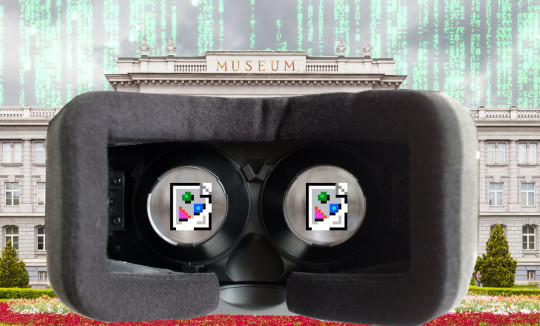
I'll be at the Studio City branch of the LA Public Library tonight (Monday, November 13) at 1830hPT to launch my new novel, The Lost Cause. There'll be a reading, a talk, a surprise guest (!!) and a signing, with books on sale. Tell your friends! Come on down!

The great irony of the platformization of the internet is that platforms are intermediaries, and the original promise of the internet that got so many of us excited about it was disintermediation – getting rid of the middlemen that act as gatekeepers between community members, creators and audiences, buyers and sellers, etc.
The platformized internet is ripe for rent seeking: where the platform captures an ever-larger share of the value generated by its users, making the service worst for both, while lock-in stops people from looking elsewhere. Every sector of the modern economy is less competitive, thanks to monopolistic tactics like mergers and acquisitions and predatory pricing. But with tech, the options for making things worse are infinitely divisible, thanks to the flexibility of digital systems, which means that product managers can keep subdividing the Jenga blocks they pulling out of the services we rely on. Combine platforms with monopolies with digital flexibility and you get enshittification:
https://pluralistic.net/2023/01/21/potemkin-ai/#hey-guys
An enshittified, platformized internet is bad for lots of reasons – it concentrates decisions about who may speak and what may be said into just a few hands; it creates a rich-get-richer dynamic that creates a new oligarchy, with all the corruption and instability that comes with elite capture; it makes life materially worse for workers, users, and communities.
But there are many other ways in which the enshitternet is worse than the old good internet. Today, I want to talk about how the enshitternet affects openness and all that entails. An open internet is one whose workings are transparent (think of "open source"), but it's also an internet founded on access – the ability to know what has gone before, to recall what has been said, and to revisit the context in which it was said.
At last week's Museum Computer Network conference, Aaron Straup Cope gave a talk on museums and technology called "Wishful Thinking – A critical discussion of 'extended reality' technologies in the cultural heritage sector" that beautifully addressed these questions of recall and revisiting:
https://www.aaronland.info/weblog/2023/11/11/therapy/#wishful
Cope is a museums technologist who's worked on lots of critical digital projects over the years, and in this talk, he addresses himself to the difference between the excitement of the galleries, libraries, archives and museums (GLAM) sector over the possibilities of the web, and why he doesn't feel the same excitement over the metaverse, and its various guises – XR, VR, MR and AR.
The biggest reason to be excited about the web was – and is – the openness of disintermediation. The internet was inspired by the end-to-end principle, the idea that the network's first duty was to transmit data from willing senders to willing receivers, as efficiently and reliably as possible. That principle made it possible for whole swathes of people to connect with one another. As Cope writes, openness "was not, and has never been, a guarantee of a receptive audience or even any audience at all." But because it was "easy and cheap enough to put something on the web," you could "leave it there long enough for others to find it."
That dynamic nurtured an environment where people could have "time to warm up to ideas." This is in sharp contrast to the social media world, where "[anything] not immediately successful or viral … was a waste of time and effort… not worth doing." The social media bias towards a river of content that can't be easily reversed is one in which the only ideas that get to spread are those the algorithm boosts.
This is an important way to understand the role of algorithms in the context of the spread of ideas – that without recall or revisiting, we just don't see stuff, including stuff that might challenge our thinking and change our minds. This is a much more materialistic and grounded way to talk about algorithms and ideas than the idea that Big Data and AI make algorithms so persuasive that they can control our minds:
https://pluralistic.net/2023/11/06/attention-rents/#consumer-welfare-queens
As bad as this is in the social media context, it's even worse in the context of apps, which can't be linked into, bookmarked, or archived. All of this made apps an ominous sign right from the beginning:
https://memex.craphound.com/2010/04/01/why-i-wont-buy-an-ipad-and-think-you-shouldnt-either/
Apps interact with law in precisely the way that web-pages don't. "An app is just a web-page wrapped in enough IP to make it a crime to defend yourself against corporate predation":
https://pluralistic.net/2023/08/27/an-audacious-plan-to-halt-the-internets-enshittification-and-throw-it-into-reverse/
Apps are "closed" in every sense. You can't see what's on an app without installing the app and "agreeing" to its terms of service. You can't reverse-engineer an app (to add a privacy blocker, or to change how it presents information) without risking criminal and civil liability. You can't bookmark anything the app won't let you bookmark, and you can't preserve anything the app won't let you preserve.
Despite being built on the same underlying open frameworks – HTTP, HTML, etc – as the web, apps have the opposite technological viewpoint to the web. Apps' technopolitics are at war with the web's technopolitics. The web is built around recall – the ability to see things, go back to things, save things. The web has the technopolitics of a museum:
https://www.aaronland.info/weblog/2014/09/11/brand/#dconstruct
By comparison, apps have the politics of a product, and most often, that product is a rent-seeking, lock-in-hunting product that wants to take you hostage by holding something you love hostage – your data, perhaps, or your friends:
https://www.eff.org/deeplinks/2021/08/facebooks-secret-war-switching-costs
When Anil Dash described "The Web We Lost" in 2012, he was describing a web with the technopolitics of a museum:
where tagging was combined with permissive licenses to make it easy for people to find and reuse each others' stuff;
where it was easy to find out who linked to you in realtime even though most of us were posting to our own sites, which they controlled;
where a link from one site to another meant one person found another person's contribution worthy;
where privacy-invasive bids to capture the web were greeted with outright hostility;
where every service that helped you post things that mattered to you was expected to make it easy for you take that data back if you changed services;
where inlining or referencing material from someone else's site meant following a technical standard, not inking a business-development deal;
https://www.anildash.com/2012/12/13/the_web_we_lost/
Ten years later, Dash's "broken tech/content culture cycle" described the web we live on now:
https://www.anildash.com/2022/02/09/the-stupid-tech-content-culture-cycle/
found your platform by promising to facilitate your users' growth;
order your technologists and designers to prioritize growth above all other factors and fire anyone who doesn't deliver;
grow without regard to the norms of your platform's users;
plaster over the growth-driven influx of abusive and vile material by assigning it to your "most marginalized, least resourced team";
deliver a half-assed moderation scheme that drives good users off the service and leaves no one behind but griefers, edgelords and trolls;
steadfastly refuse to contemplate why the marginalized users who made your platform attractive before being chased away have all left;
flail about in a panic over illegal content, do deals with large media brands, seize control over your most popular users' output;
"surface great content" by algorithmically promoting things that look like whatever's successful, guaranteeing that nothing new will take hold;
overpay your top performers for exclusivity deals, utterly neglect any pipeline for nurturing new performers;
abuse your creators the same ways that big media companies have for decades, but insist that it's different because you're a tech company;
ignore workers who warn that your product is a danger to society, dismiss them as "millennials" (defined as "anyone born after 1970 or who has a student loan")
when your platform is (inevitably) implicated in a murder, have a "town hall" overseen by a crisis communications firm;
pay the creator who inspired the murder to go exclusive on your platform;
dismiss the murder and fascist rhetoric as "growing pains";
when truly ghastly stuff happens on your platform, give your Trust and Safety team a 5% budget increase;
chase growth based on "emotionally engaging content" without specifying whether the emotions should be positive;
respond to ex-employees' call-outs with transient feelings of guilt followed by dismissals of "cancel culture":
fund your platforms' most toxic users and call it "free speech";
whenever anyone disagrees with any of your decisions, dismiss them as being "anti-free speech";
start increasing how much your platform takes out of your creators' paychecks;
force out internal dissenters, dismiss external critics as being in conspiracy with your corporate rivals;
once regulation becomes inevitable, form a cartel with the other large firms in your sector and insist that the problem is a "bad algorithm";
"claim full victim status," and quit your job, complaining about the toll that running a big platform took on your mental wellbeing.
https://pluralistic.net/2022/02/18/broken-records/#dashes
The web wasn't inevitable – indeed, it was wildly improbable. Tim Berners Lee's decision to make a new platform that was patent-free, open and transparent was a complete opposite approach to the strategy of the media companies of the day. They were building walled gardens and silos – the dialup equivalent to apps – organized as "branded communities." The way I experienced it, the web succeeded because it was so antithetical to the dominant vision for the future of the internet that the big companies couldn't even be bothered to try to kill it until it was too late.
Companies have been trying to correct that mistake ever since. After three or four attempts to replace the web with various garbage systems all called "MSN," Microsoft moved on to trying to lock the internet inside a proprietary browser. Years later, Facebook had far more success in an attempt to kill HTML with React. And of course, apps have gobbled up so much of the old, good internet.
Which brings us to Cope's views on museums and the metaverse. There's nothing intrinsically proprietary about virtual worlds and all their permutations. VRML is a quarter of a century old – just five years younger than Snow Crash:
https://en.wikipedia.org/wiki/VRML
But the current enthusiasm for virtual worlds isn't merely a function of the interesting, cool and fun experiences you can have in them. Rather, it's a bid to kill off whatever is left of the old, good web and put everything inside a walled garden. Facebook's metaverse "is more of the same but with a technical footprint so expensive and so demanding that it all but ensures it will only be within the means of a very few companies to operate."
Facebook's VR headsets have forward-facing cameras, turning every users into a walking surveillance camera. Facebook put those cameras there for "pass through" – so they can paint the screens inside the headset with the scene around you – but "who here believes that Facebook doesn't have other motives for enabling an always-on camera capturing the world around you?"
Apple's VisionPro VR headset is "a near-perfect surveillance device," and "the only thing to save this device is the trust that Apple has marketed its brand on over the last few years." Cope notes that "a brand promise is about as fleeting a guarantee as you can get." I'll go further: Apple is already a surveillance company:
https://pluralistic.net/2022/11/14/luxury-surveillance/#liar-liar
The technopolitics of the metaverse are the opposite of the technopolitics of the museum – even moreso than apps. Museums that shift their scarce technology budgets to virtual worlds stand a good chance of making something no one wants to use, and that's the best case scenario. The worst case is that museums make a successful project inside a walled garden, one where recall is subject to corporate whim, and help lure their patrons away from the recall-friendly internet to the captured, intermediated metaverse.
It's true that the early web benefited from a lot of hype, just as the metaverse is enjoying today. But the similarity ends there: the metaverse is designed for enclosure, the web for openness. Recall is a historical force for "the right to assembly… access to basic literacy… a public library." The web was "an unexpected gift with the ability to change the order of things; a gift that merits being protected, preserved and promoted both internally and externally." Museums were right to jump on the web bandwagon, because of its technopolitics. The metaverse, with its very different technopolitics, is hostile to the very idea of museums.
In joining forces with metaverse companies, museums strike a Faustian bargain, "because we believe that these places are where our audiences have gone."
The GLAM sector is devoted to access, to recall, and to revisiting. Unlike the self-style free speech warriors whom Dash calls out for self-serving neglect of their communities, the GLAM sector is about preservation and access, the true heart of free expression. When a handful of giant companies organize all our discourse, the ability to be heard is contingent on pleasing the ever-shifting tastes of the algorithm. This is the problem with the idea that "freedom of speech isn't freedom of reach" – if a platform won't let people who want to hear from you see what you have to say, they are indeed compromising freedom of speech:
https://pluralistic.net/2022/12/10/e2e/#the-censors-pen
Likewise, "censorship" is not limited to "things that governments do." As Ada Palmer so wonderfully describes it in her brilliant "Why We Censor: from the Inquisition to the Internet" speech, censorship is like arsenic, with trace elements of it all around us:
https://www.youtube.com/watch?v=uMMJb3AxA0s
A community's decision to ban certain offensive conduct or words on pain of expulsion or sanction is censorship – but not to the same degree that, say, a government ban on expressing certain points of view is. However, there are many kinds of private censorship that rise to the same level as state censorship in their impact on public discourse (think of Moms For Liberty and their book-bannings).
It's not a coincidence that Palmer – a historian – would have views on censorship and free speech that intersect with Cope, a museum worker. One of the most brilliant moments in Palmer's speech is where she describes how censorship under the Inquistion was not state censorship – the Inquisition was a multinational, nongovernmental body that was often in conflict with state power.
Not all intermediaries are bad for speech or access. The "disintermediation" that excited early web boosters was about escaping from otherwise inescapable middlemen – the people who figured out how to control and charge for the things we did with one another.
When I was a kid, I loved the writing of Crad Kilodney, a short story writer who sold his own self-published books on Toronto street-corners while wearing a sign that said "VERY FAMOUS CANADIAN AUTHOR, BUY MY BOOKS" (he also had a sign that read, simply, "MARGARET ATWOOD"). Kilodney was a force of nature, who wrote, edited, typeset, printed, bound, and sold his own books:
https://www.theglobeandmail.com/arts/books/article-late-street-poet-and-publishing-scourge-crad-kilodney-left-behind-a/
But there are plenty of writers out there that I want to hear from who lack the skill or the will to do all of that. Editors, publishers, distributors, booksellers – all the intermediaries who sit between a writer and their readers – are not bad. They're good, actually. The problem isn't intermediation – it's capture.
For generations, hucksters have conned would-be writers by telling them that publishing won't buy their books because "the gatekeepers" lack the discernment to publish "quality" work. Friends of mine in publishing laughed at the idea that they would deliberately sideline a book they could figure out how to sell – that's just not how it worked.
But today, monopolized film studios are literally annihilating beloved, high-priced, commercially viable works because they are worth slightly more as tax writeoffs than they are as movies:
https://deadline.com/2023/11/coyote-vs-acme-shelved-warner-bros-discovery-writeoff-david-zaslav-1235598676/
There's four giant studios and five giant publishers. Maybe "five" is the magic number and publishing isn't concentrated enough to drop whole novels down the memory hole for a tax deduction, but even so, publishing is trying like hell to shrink to four:
https://pluralistic.net/2022/11/07/random-penguins/#if-you-wanted-to-get-there-i-wouldnt-start-from-here
Even as the entertainment sector is working to both literally and figuratively destroy our libraries, the cultural heritage sector is grappling with preserving these libraries, with shrinking budgets and increased legal threats:
https://blog.archive.org/2023/03/25/the-fight-continues/
I keep meeting artists of all description who have been conditioned to be suspicious of anything with the word "open" in its name. One colleague has repeatedly told me that fighting for the "open internet" is a self-defeating rhetorical move that will scare off artists who hear "open" and think "Big Tech ripoff."
But "openness" is a necessary precondition for preservation and access, which are the necessary preconditions for recall and revisiting. Here on the last, melting fragment of the open internet, as tech- and entertainment-barons are seizing control over our attention and charging rent on our ability to talk and think together, openness is our best hope of a new, good internet. T
he cultural heritage sector wants to save our creative works. The entertainment and tech industry want to delete them and take a tax writeoff.
As a working artist, I know which side I'm on.

If you'd like an essay-formatted version of this post to read or share, here's a link to it on pluralistic.net, my surveillance-free, ad-free, tracker-free blog:
https://pluralistic.net/2023/11/13/this-is-for-everyone/#revisiting

Image: Diego Delso (modified) https://commons.wikimedia.org/wiki/File:Museo_Mimara,_Zagreb,_Croacia,_2014-04-20,_DD_01.JPG
CC BY-SA 4.0 https://creativecommons.org/licenses/by-sa/4.0/
#pluralistic#ar#xr#vr#augmented reality#extended reality#virtual reality#museums#cultural preservation#aaron cope#Museum Computer Network#cultural heritage#glam#access#open access#revisiting#mr#mixed reality#asynchronous#this is for everyone#freedom of reach#gatekeepers#metaverse#technofeudalism#privacy#brick on the face#rent-seeking
189 notes
·
View notes
Text
Celestino Vietti, I’m one with the bike

From the Piemonte Alps to Moto2. Interview to the SKY Racing Team VR46 talent
“The most beautiful memory I have of my childhood is tied to a three wheels bike. My dad had built it for my older brother, using the engine of a grass trimmer. I used to look at my brother going around on it in the backyard, then one day I asked to try it: once I got on it I irremediably fell in love with engines. Once I got down from that first trial I immediately asked my dad to buy me a two wheels motorbike. “To have a bike without training wheels you first have to know how to ride with them”, was his answer. So I started training and at eight years old I found myself riding in my first italian championship...”
Celestino Vietti is lightness, a youthly lightness, a mature lightness, a fast lightness, cheeky to the right degree. Not yet twenty, he’s approaching his first Moto2 season, wearing the SKY Racing Team VR 46 leathers on Marco Bezzecchi’s side.

Leathers that ‘Celin’ paints with the colours of his region, Piemonte. Right in Coassolo Torinese, small settlement wedged between the Valli di Lanzo, two wheels racing had started indelibly marking his life. An atypical place, Alpi Graie, to be the natal place of a world championship level rider. A place that becomes typical as soon as you open wide the doors of the Vietti’s home.
“My uncle and my dad have always been big enthusiasts. My dad even did some uphill races when he was young. I lived all my childhood in a motorsport enviroment. My relatives had and still now have an agricultural machine repair shop that rapidly became a mandatory stop of my summers. There I used to take apart chainsaws and everything else I could find. Now I realise that the time spent in the repair shop gifted me a better feeling with the engine, with mechanics. My dad also gave me a lot of tools to read and understand the bike’s problems: thanks to him my bond with the bike got to a superior level. It’s as if I feel more merged with what I have under me, I listen to every single sound, I know how to decipher and manage it...”

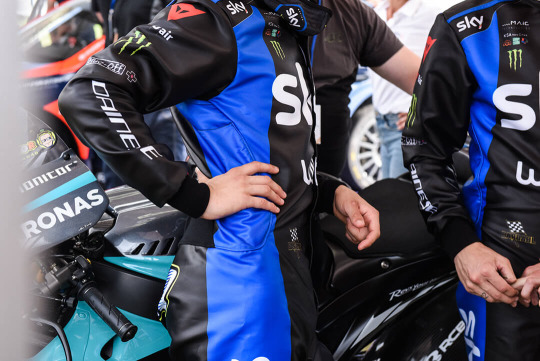
A management that for this young promise of two wheels racing hasn’t been and isn’t limited to the technical side, overflowing in the character, human one. Sat in the shades of the WITHU paddock, what immediately hits you of Celestino are the lucidity in the self-analysis, the ease in communicating, in summarising the different steps he took in such a short, but already so full, life.
“To follow my dream I had to move out of my home during adolescence. The first months were so fast, everything was new, new experiences, new acquaintances. Once you settle you start thinking that once you get home from training nobody is there to wait for you. Relatives, friends, everybody is distant, everything starts getting hard. I had to grow on a personal level and, consequently, as a rider. Situations like this teach you how to manage yourself on the emotional side: sometimes I tend to get angry easily, being this much on your own helps you to reflect, to remain lucid”
Vietti’s growth was mainly through the motorsport Academy for definition, that two wheels paradise build by the tarmac’s ‘Doctor’. A restricted cenacle reserved only to those who are destined to make an art form out of racing. Disciples, students, riders waiting to see their own boundless talent explode.
“Getting into the VR46 Racing Academy was a turning point. It's important to realise your luck, the privilege you have to train every day with the best riders in the World Championship. Every time you get on track it’s an enormous challenge, there’s always somebody faster than you. I try to look at everyone, we’re many, we’re ‘colourful’, everyone has a certain characteristic to learn from: I have by my side two World Champions and then Vale, my idol, I think there’s nothing else to add...”
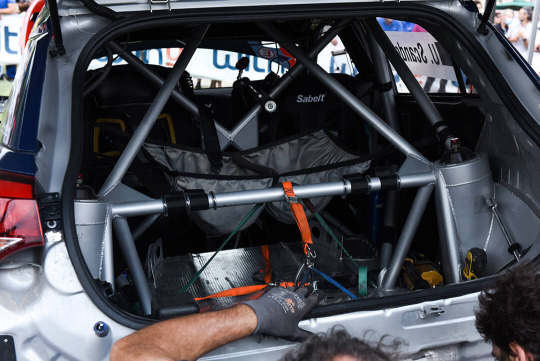

He slightly moves his hair out of the way, Celestino, when he talks about topics he’s particularly sensible about. He smiles, a sincerely emotional smile, when he gets asked what the bike means for him, for his being. A question that strikes way higher chords than the sports one.
“When you go really fast you become one with her, you find a magic harmony. Whatever she wants to do, you do it too, you become one thing. When she wants to do one thing, and you want to do another one instead, you struggle. True struggle. You can feel the separation between the two bodies. For me the bike has some sort of life of his own: it’s something difficult to explain”

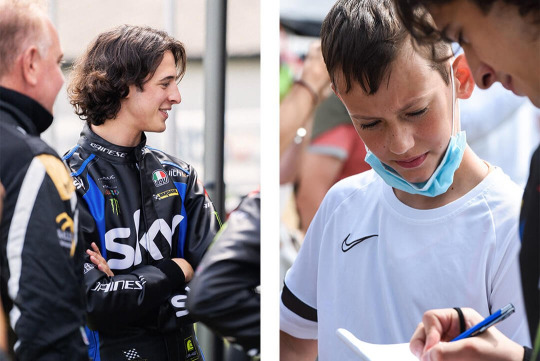

Difficult to explain, evocative to listen to. There’s dept in the words of this barely more than teenager rider of the Sky Team. On him also weight hopes and expectations of many italian fans, charmed by his results in the 2020 Moto3 season and the two first places obtained in the Styrian and France GP.
Celestino is lucid in his analysis of the big jump to Moto2, a natural jump, even though initially complex. The piemonte rider need a settling period, an adjustment phase that now appears completed, processed. To demonstrate it, an always growing confidence in placements and continuity of performances, an exponentially growing mental and sensorial presence.
“The impact with Moto2 was difficult. It’s a very particular category, unlike Moto3 it rewards constancy, precision, the bike doesn’t want to be assaulted, you can’t afford to do ‘crazy’ lap and feel satisfied. You have to curate the rhythm, you need surgical attention. Now my goal is to get as high as I can in the standings, to continue with the positive feelings of the last races and to keep building up unity with the bike. The future? Everybody’s dream is to become world champion, it’s useless beating around the bush, I’ll work hard to be able to make it”

45 notes
·
View notes
Text
In response to this post:
I think it's because it has the best story progression and build up.
Everyone appreciates a story with rising action, climax, and resolution. You need the "lows" in order for the "highs" to stand out, and vice versa. A small problem some other chapters had was the use of too much "high", tense moments, which results in feeling like the player was just thrown into the climax of a story.
One thing Xkour also does with its "low"s is set up a growing sense of unease, teasing the player with mystery.
Xkour starts with a friendly tutorial into the game, the player feels welcomed as no imminent threat is found. However, that changes as the tutorial goes slightly haywire and with the newly learnt fact that dying actually has consequences. This unease steadily grows until the third quest where it reaches its peak. So, what does the summoner do? Flee this "peace" and "fun" to find out the dangerous truth behind it all. One exposition later, and we've reached the first climax and subsequent resolution. Beautiful.
But of course, the story isn't done. After the first resolution, we get another moment of "low"s getting "higher" as the guardian trials start, but similarly with that unease that something is wrong back at main and even here. This time, instead of reaching its peak when the exposition drops, the story suddenly goes into a relative "low" with the reveal that the threat, the creator, wasn't here all along. But of course, it almost immediately shifts back into a "high" once another similar truth is revealed. So then we have the big climax of the whole two chapters, and then the story somewhat manages with its resolution.
Another thing would be the story's relatability.
What I mean is that players can easily connect with the characters that appear since everyone is a player here. (Also, who doesn't like the idea of a VR parkour game?) So this connection makes the stakes hit harder.
The ultimate threat of this chapter is the imprisonment and brainwashing of the players. And I assume it's easier to understand the dread of being trapped forever as opposed to other fantastical threats.
The story also uses Cyto as a way to personalise the danger of being potentially stuck in a game forever. Something about feeling more for one person's story rather than a general populace's. Although that may be the case, the story kind of fails to deliver on his anguish and thus people, us, are going to rewrite that sh** because it's too good to give up on.
(Luna's emotional anguish with herself as a program rather than a real being was also a treat.)
Another neat thing about Xkour is that it's the only chapter to have a clear connection to Luni that isn't about the swords of corruption.
There are a plethora of other minor things about this story that compile up to make this my favourite two chapters in Gacha World, some of which may differ from individuals.
tldr:
The Xkour storyline applies story writing 101 (the hill) well enough and is quite relatable, allowing the player to easily get invested into the story.
Cyto is an underrated character with almost as much emotional baggage as DJ X, and that's something this small community likes to see.
(I say that with a straight face as I continue typing out my currently 2600 word count analysis on Vale in canon and her despair with being trapped under C!Kilios' rule.)
Goodness, I love Xkour.
#gacha world#xkour#xkour skylines#gw cyto#{(You mention Xkour I'll come running to get to you.)}#{(That's what that smiley face was for OP.)}#{(I know it was a semi joke but duck it why not post a short analysis on main?)}
22 notes
·
View notes
Text
3/30: Meet David
(Previous) | (Index) | (Next)
⛬
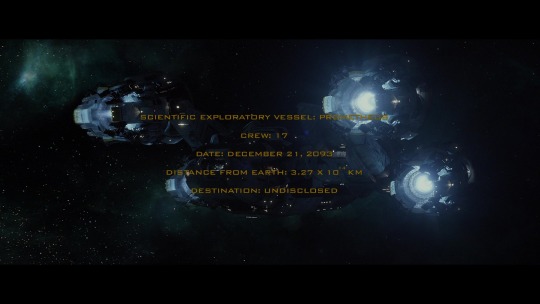
We return to the movie I want to bite down on with all of my teeth, Prometheus.
This time, we meet a man so bored he has invented new solo sports and started doing his hair like his blorbo, T.E. Lawrence.
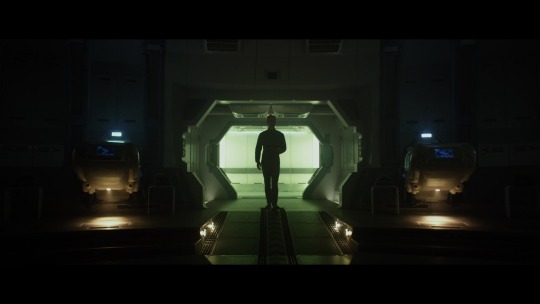
Meet David (Michael Fassbender). He’s implied to be a little over two years old, and he’s been completely alone for the vast majority of his life.
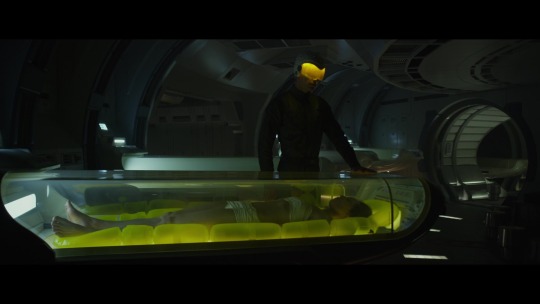
Actually, I lied. The movie first wants to throw another small strain on our suspension of disbelief: David has a VR visor he can use to view the dreams of the human crew in suspended animation. This is technically a plot point, and thus it is delivered with all the grace of this deer.
youtube
I cannot emphasize enough how clunky the movie becomes when plot or deliberate character arcs are being communicated through dialog scenes.


We find out from dream-peeping that Elizabeth Shaw’s father (horror actor Patrick Wilson) was a devout christian of some variety, possibly a missionary, and her mom died when she was young. She was given a cross necklace, which we see in blurry montage-o-vision before David wanders off.
We see David’s routine: Pick up tiny specks of dust, send out first contact messages and receive no response, perfect the lonely sport of solo bicycle-riding shootout, eat android breakfast and take a Proto-Indo-European language lesson, watch Lawrence of Arabia (1962) while dying his roots, and quote the most Definitely Not Suffering line to himself over and over again as he does his hair like Peter O’Toole and wanders the halls, waiting for something to happen. “The trick, William Potter, is not minding that it hurts.”
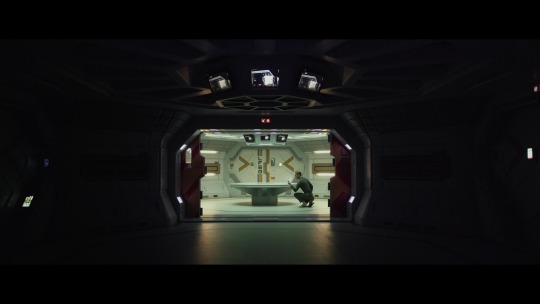
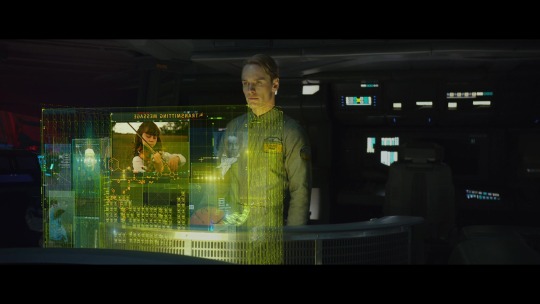
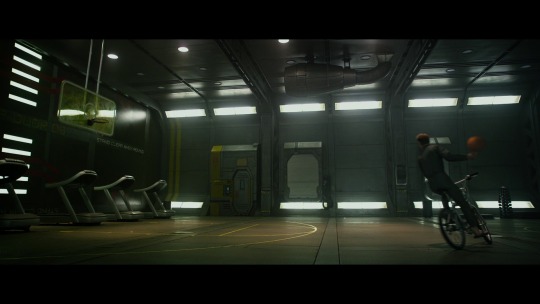
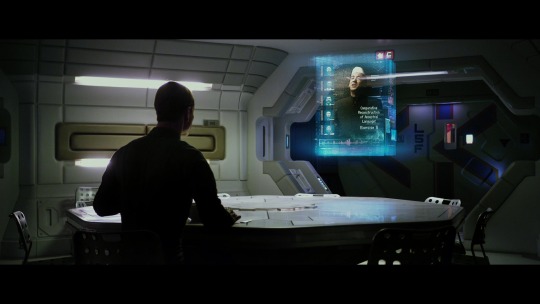
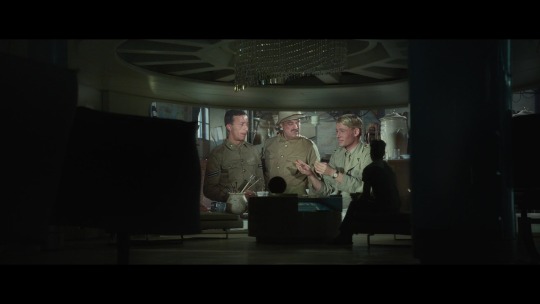
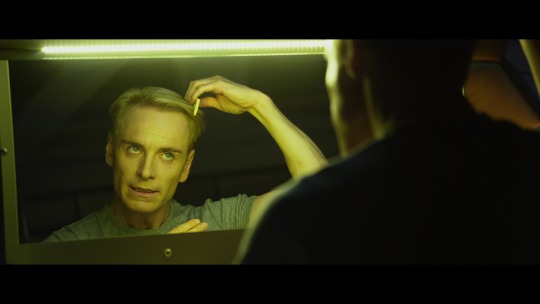
David is going to later profess to have no emotions, but I think that given the chance, he would at least admit his enclosure needs enrichment.
This is one of the strongest scenes in the movie. David is a novel creation of humanity, and he has been left alone, with only the memories and dreams of humans to extrapolate off of. He has been abandoned without thought for his needs, stuffed down into Plato's Cave. We don’t know yet whether the people on the ship see him as a person, but we know they’re thoughtless in how they’ve treated him. He’s bright, he’s inventive, he’s chosen a way he wants to be seen, but he’s seen by no one.
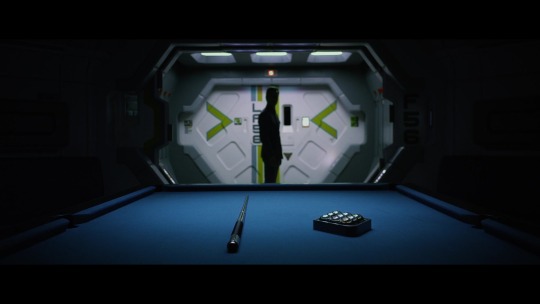
I’m sure this is going to turn out great for everybody.
And as a side note, while I didn’t know it at the time, David’s language tutor is the actual historical linguist that they employed for the movie, Anil Biltoo. His and Fassbender’s pronunciations were strong enough that even a hobbyist in linguistics could tell that they were really, really trying to get it right. They even reference Schleicher’s fable, the first piece of text anyone ever created from reconstructed Proto-Indo-European. This level of nerdy detail made me excited.
Side note to the side note, Biltoo also has an introductory textbook on Sanskrit you can buy, if you’re a maniac like I am.
This scene kept part of me hopeful for the rest of the movie, because it’s so strong. The “not minding that it hurts” line is a little on the nose, but overall it has the feel of something that could be expanded into an extremely melancholy short film. Or, hell, a Tarkovsky-esque feature film. Moon (2009) could be another point of comparison. In any case, this scene gives you a little space to feel all the quiet suffering of David’s existence.
But unfortunately for the movie as a whole, this sets David up as the most sympathetic character. I personally had already been drawn in by the promotional “advert” for the David-8 model android (see part 1). Now I was invested in this particular David’s story. The rest of the film didn’t manage to yank back much sympathy for anybody else.
Because the general vibe I soon picked up from the rest of the crew was that they were absolute hooting jackasses.
⛬
(Previous) | (Index) | (Next)
⛬
Sources alt-text facts:
1. https://www.denofgeek.com/movies/how-ron-perlman-nearly-ruined-the-alien-resurrection-basketball-shot/
2. https://www.imdb.com/name/nm0766970/?ref_=ttfc_fc_cl_t50
#Prometheus 2012#Lawrence of Arabia is 131 years old in this movie#For a point of comparison:#that's like someone today basing their style off of Mark Twain's Pudd'nhead Wilson#Not the worse choice but certainly not the first one someone would reach for
39 notes
·
View notes
Text
I have always fantasized about the idea of being a cybergenic system. About having a software that could be downloaded into my exocortex to help facilitate the process of becoming plural. The idea that Thanks to the vast amount of computing and neural reverse engineering from the singularity, consciousness could be modified on a whim to create or merge identities in nanoseconds.
I know i can make a system right now and I do plan to, but the idea of cybernetically augmented plurality sounds so awesome. I would love to have millions of headmates and not worry about a headache. Plus we could all be doing stuff inside online vr while somebody else fronts. Some of us could act as a live firewall to prevent mind hacking while others manage system processes.
The applications for cybernetics in the created plurality community are huge.
Virtuagenic systems are also cool.
3 notes
·
View notes
Text
Jeremy B [FNAF, Renegade AU]
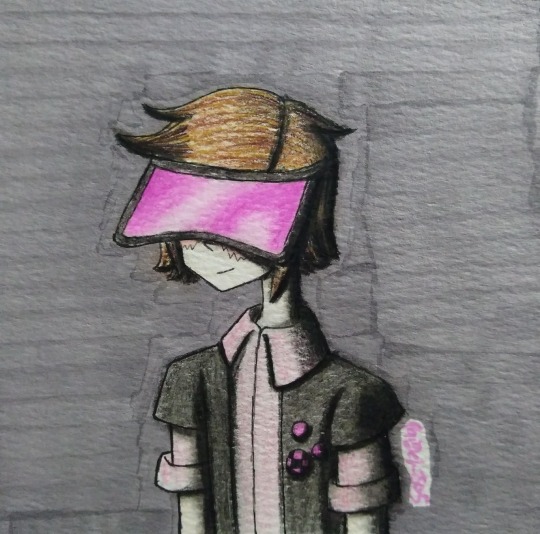
Published: Dec 1, 2024
https://www.deviantart.com/paigelts05/art/1128508541
Fazbear Entertainment had had a terrible impact on Jeremy B's life before he was even a twinkle in his parents eyes. It's no wonder that when presented with the opportunity to find out why from the source, he took it.
Jeremy B has an older brother named Roy, but Jeremy never got to see his brother alive, as in 1987, Roy was killed as a part of Location C's MCI. Jeremy was born nine years later, and was unaware that he'd ever had a brother until he was a teenager, when a journalist managed to contact him and inform him of said brother's existence, leaving a business card for if Jeremy wanted to find out more.
Jeremy B asked his parents about his brother, and they told him very little, but enough to verify that he did in fact have a dead 'older' brother, and that said brother did in fact die in Freddy's Location C back in 1987.
When Jeremy was in college, he and some of his friends formed a small games company called "Silver Parasol". The company consisted of himself, Cassey, Sylvia Blake, and Vanessa Diego. The four worked on several arcade style mobile games together before they were contacted by Faz Ent.
Work on their VR game; get a hefty paycheque.
Jeremy remembered the journalist and was all in on the VR game deal: he'd been considering contacting the journalist for a few years, but he'd been putting it off.
Maybe he'd see what he could find on his own first.
Jeremy volunteered as the first playtester.
As he tested the game, he looked into every little thing that he could, and he wound up happening across something strange. After scanning in a chip that correponded to a 'Spring Bonnie', something that appeared to be a yellow rabbit, green with wireframe, boasting piercing purple eyes, started to appear and seemed to be trying to communicate with him. It started to rearrange the code, but it was far from clean: it wasn't clear if this was an AI or a ghost, as both had been known to be able to bend code to their will from the inside.
Jeremy was initially wary around the rabbit, but it seemed to know things. Things about Freddy's, things about his past. It seemed to struggle to find a voice of its own - both AIs and ghosts tended to share this issue, so there was still no way of knowing who or what it was, but Jeremy B tentatively listened, trying to figure out this creatures story, and just how much of what it was telling him was the truth.
One thing was clear, however: this entity was a threat. One Jeremy wasn't sure how to deal with. It seemed as if during their conversations, this entity had been getting into Jeremy's head, not just metaphorically, but literally. It seemed to be trying to posess him.
The team had to get this thing out of the game somehow: who knows what it could do if the game was allowed to release. If it was an AI that could posess people, it could replicate. If it was a ghost, then the game could create a network that would let it posess anyone at any time. This was a bug that had to be patched out before it made it to production at all costs.
Cassey logged what was found in some audio files whilst she, Ness, and Sylvia tried their best to eliminate this entity, meanwhile Jeremy's job was to hunt it down wherever it hid and report back its newest hiding spot.
The game of cat and mouse could only last so long, as there were only so many levels for it to hide in, and Jeremy eventually cornered it at a new stage that popped up. A stage called 'Pizza Party'. He hunter down the rabbit through the maze of halls, and eventually, they hit what Jeremy thought was a dead end: a chance to catch it.
It was hiding behind a curtain, but gesturing for Jeremy to follow it.
Jeremy thought he'd caught the glitchy rabbit, but as soon as he got too close to the curtains, the headset went dark, and Jeremy found himself unable to move. Not just in game, but his actual body eas frozen. In the game, he was on a stage, overlooking a dining hall, and he saw the rabbit dancing, and he heard a man's voice singing.
Jeremy B begun to have vivid visions of events he never saw:
In a desolate CEOs office a man fought against the ghost of a man who called himself William. William smashed the man's dead into a broken broken guillotine paper cutter on the desk, but the man whose memories he was witnessing survived. The man then went on to win the fight.
In a crumbling warehouse, he saw a woman rally an army of animatronics against an animatronic rabbit that held the bones of a long dead killer, and seemed to be posessed by that killer too. The woman called the rabbit 'Afton'. One of the woman's friends called the rabbit 'William'.
The visions flicker by faster and faster, as as the in-game handunit echoed out that there was nothing more to find, the visions abruptly stopped, and Jeremy collapsed, seemingly having been let go of whatever was holding him still. But he knew a lot more now. This entity was the ghost of William Afton.
Jeremy spent a lot more time in the testing room after this, constantly trying to hunt down William again, but always being frozen by visions. He doesn't remember much of this time, but he remembers one thing: when William tried to take full control over his body, he remebered the man who fought William in the dilapidated CEOs office. He used the office's own guillotine paper cutter to slice the VR headset off of his own face.
He came to in the hospital some days later. In that time, Sylvia had been posessed, Cassey fragmented William and drove him back into the game, Cassey hired a PI who shared Jeremy's forename and the PI helped her eradicate William from the game, and Cassey had lost and eye in the process.
Jeremy B had woken up just in time for Ness to go through the game to make sure that William was no longer in the game.
Nobody had suspected that he would have hid himself in the hardware.
William was able to posess Ness easily, and nothing the team tried could get him out of her mind.
All they could do now was contain William in order to prevent Faz Ent from getting their hands on their CEO's ghost. The game was no longer an attack vector, so Jeremy helped Cassey and Sylvia polish the game up to try and share their story and cover up the fact that William had latched onto someone already.
It was a pyrrhic victory though: Jeremy had lost his face, Sylvia had lost her mind, Cassey had lost and eye, and Ness now had William stuck in her brain.
But they all had a means of coping: Jeremy started to wear a visor to cover the scar, Cassey had a glass eye, and Sylvia found a specialised therapist. Ness, however, left the team: she was worried that William would hurt them if given the chance. Jeremy and the others understood completely.
After all of that chaos, Silver Parasol disbanded, but it was on paper only. The troupe became a ska band under the same name in order to keep their team's identity whilst Faz Ent effectively tried to fight air. In the meantime, Jeremy and Cassey also joined Sylvia as paranormal responders so they could help Ness from the sidelines.
But that wasn't the only help they offered. The game developing ska band created a mobile game called Princes Quest in order to subtly share Ness's story and hopefully create a new way to get William out of Ness's head. Three games were made in total, and Cassey made a mobile port of each of them, because arcade cabinets have a history of being a favoured method for ghosts and technology to effect one another: from the 'Maiden's tale' game that was a ghost-run puppet show performed in order to help a security guard withstand Gerald Taylor's influence, to the arcades that Theren played that helped many MCI kids find their happiest day. It was clear that if Princess Quest was to help Ness, an arcade port was their best shot.
During this time, Jeremy also decided to contact the journalist and arranged to meet him. Jeremy recognised the journalist from his visions, and the two discussed what they knew about Freddy's. The journalist then offered to let Jeremy B see his 'older' brother; this was a huge act of trust, as Jeremy B already knew how dangerous Freddy's was, now having some first hand experience in the matter, and that his brother would probably kill him, but Jeremy B just wanted to see his brother at least once in his life.
The visit went better than expected. Roy seemed happy to see his 'little' brother, and Jeremy felt as if he'd finally found what had been missing. Roy did, however, bestow a small parting gift, unknown to either Jeremy or the Journalist: the ability to sense death.
A few years later, Silver Parasol caught wind that William was planning on spiriting Ness away to the megaplex, which at the time was still under construction. Cassey had a plan, and simply told Jeremy to wait and see.
The opening day of the megaplex arrived, help wanted ads flooded the papers, and Cassey came to Jeremy with some computer chips and some official looking documents: she had secured Jeremy a position as part of the megaplex's day security team - the legitimacy of which Jeremy left unquestioned - and needed him to install the Princess Quest ROM chips into any three arcade machines in order to set up the trilogy of games as a series of arcades; if William's plans hinged on the megaplex, then setting up the arcades in that place should help free Ness from William, whether Ness was at the megaplex or not.
Whrn Ness went missing later that year, Jeremy noticed that both Princess Quest 1 and Princess Quest 3 had been moved.
He searched for them, but with no leads and his clearance being so low that he was forced to take vents to so much as get to his post, he couldn't find them.
To make matters more interesting, Sylvia had taken up the position of head of security recently too. He figured that the arcades were moved just so she wouldn't find them.
Things seemed dire. But also interesting.
The first time he was actually able to talk to Sylvia was on the day of what would become known as The Riot. Jeremy was at the first meeting during the day, and had worked with Gaz to ensure that enough chaos had spread amongst staff to keep them alive. During this first incident of the day, he found Sylvia and Luis in the changing rooms, with Sylvia having just had a panic attack over the fact that she was the only guard who had not been sacked. Whilst Jeremy had saved everyone at the meeting at the staff cafeteria, he also knew that at 11 AM, prior to the meeting that Jeremy thwarted, the construction crew had been killed. He didn't tell Sylvia, lest the fact that people had already died today freak her out, as Sylvia was already in a mentally fragile state. Instead, he helped her pull herself together, and they unscrewed a bunch of doors, clearing out most of the maintenance tunnels before they went to the 11:30 PM All Staff Meeting that was also held at the staff cafeteria, which Jeremy and Sylvia already knew would be used to not just sack the rest of the staff, but would be used by management to attempt to kill any living being in the building.
Arriving slightly late was a good call, as it gave Sylvia the jump on an exec who had held the head technician at gunpoint, and from there, Jeremy incited the rest of the staff to rally and fight against the staffbots and endos, as with most staff having access to at least one or more of a FazCam, Fazerblaster, or a flash beacon, rendering the animatronics immobile in order to pick them off was a cinch. Jeremy stayed at the staff cafeteria to protect the rest of the staff, whilst Sylvia went off to the daycare, as there were some staff who had been unable to leave their posts who would now be trapped there.
When the morning arrived, Jeremy already knew that nobody had died during the buildings nightly lockdown before everyone was counted.
A few days later, Jeremy learned that during an incident known as the Breach, Sylvia and a kid had used the Princess Quest arcades in order to free Ness. Jeremy was quite proud of both Sylvia and the kid for getting the arcades to work, and of himself for setting the arcades up, and of Cassey for being the brains behind the Princess Quest operation that orchestrated getting the games into the arcade machines of the megaplex in the first place.
Jeremy B did take part in the Raid on the Megaplex, and he helped Cassey go through the information that she gathered after. Then when the Ruins incident occured and revealed that Faz Ent had plans to not just kidnap Ness, but had plans to grab Sylvia and a small girl named Cassie as well in order to create a whole unit of Vannys, Jeremy realised that Silver Parasol would need to get back together as game developers in order to throw a spanner into the works of Faz Ent's new plans.
Jeremy helped with the development of PQ4: as William was still able to posess Ness normally and had been doing so, with Ness and her dad's ghost keeping William contained for now, PQ4 would allow Ness to seal William away in her mind, preventing him from jumping from her to anything or anyone else for as long as she lived. It was a plan that would require constant maintenance, but it would be a massive advantage in regards to keeping Faz Ent's plans at bay.
On the day where the containment was due to take place, Jeremy wasn't made aware of all of the details: he knew that Cassey and Ness would tell him after the fact. His objective was to protect the two until the process had been completed. He knew that the lack of upfront knowledge was on purpose; if someone did come to attack, Faz Ent wouldn't be able to get any information out of Jeremy. Though fortunately, no such incidents occurred, and the whole process went off without a hitch.
William was contained. Cassie and her dad were now under the protection of Silver Parasol: Cassie and her father both under Sylvia's physical protection and Cassie now a part of those who were linked to Princess Quest.
Whatever plans Faz Ent had, Silver Parasol would be right there to throw a spanner in the works.
#art#artwork#fnaf#fnaf au#renegade au#fnaf renegade au#fnaf fanart#fnaf help wanted#fnaf hw#fnaf vr help wanted#fnaf vr#fnaf vr jeremy
10 notes
·
View notes
Text
I’m going to make a masterlist for all the AUs I might write for, but in case anyone wants a taste of the kind of enabling chaos that goes on in the Superstar Daycare discord server, here’s the list of AUs I’m positively feral about:
Freddy Fazvibes (Sex Shop AU)
Digimon AU
Borderlands AU
Livestreamer / Vtuber AU
Stardew Valley AU
Color of Your Eyes AU
(Longer description of each below the readmore!)
Freddy Fazvibes (Sex Shop AU)
William accepts and admits that he has some unresolved issues between himself and Henry, and decides to open a sex shop after learning he's a furry and it makes him quite happy. The shop -- technically still under the Fazbear brand (Henry is happy for his friend but thoroughly confused) -- features character mascots and lines of toys based on the parent company alongside an up-and-coming VR system to allow people to experience the company (sexual or otherwise) of their favorite characters!
The reader is just one of many customers after discovering the niche but passionate community the store and its characters have. It's bad enough that it's a sex shop with sex toys; how are they going to handle having their favorite character offer to demonstrate using one of them?
No deaths occur in this AU, it's just some good wholesome fun (as wholesome as a sex shop can get) where we don't need to worry about why the animatronics have genitals.
Digimon AU
The reader was supposed to be a member of their generation’s digidestined, but the others were killed by a mysterious power in the digital world many years before the present day. The reader discovers this information as an adult after being pulled into the digital world by a mysterious masked puppet creature who seems to know all too much about them. Trapped, they learn that their two digimon partners (Sun and Moon) had been waiting for them all that time; waiting for their human partner that never showed up when the digital world needed them most.
The reader finds themselves battling through not only their own tentative connection with the digital world as an adult, but also with their own partner as Moon has all but rejected them due to trust and corruption issues. Can the reader heal Sun and Moon's pain, regain their trust, and manage to save the corrupted souls of the other digidestined before the digital world falls apart at the seams?
And who could this mysterious evil force even be?
Borderlands AU
Sun is a prototype of a new line of caretaker bots designed by Hyperion to serve multiple domestic roles for people rich enough to afford them. The spaceship housing him during his live beta-testing experiences an unknown error and crashes on Pandora, where the reader (an ex-Hyperion employee) rescues him from the wreckage.
Things grow even more confusing when Sun realizes that he has a second personality onboard his processors, one that the reader had inadvertently helped to create when they worked for Hyperion: Moon, a military security protocol, and the true reason that the ship had gone down over Pandora. How will Sun deal with learning that his abandonment was part of the testing -- and what will he, Moon, and the reader do when they learn about the ECLIPSE protocol?
Livestreamer / Vtuber AU
After saving them from the Pizzaplex ruins, the reader helps Sun, Moon and the newly-formed Eclipse settle into day-to-day domestic life with them. Though the reader assures that they don't need to, the three search for ways to help pay bills -- keeping them charged has tripled the electric bill alone. So, unbeknownst to the reader at first, the trio take up being a vtuber, quickly becoming quite popular for their unique avatars (which is literally just them rendered into a live2d model) and wide variety of streamed content.
They all play all sorts of videogames, but Eclipse has become very popular for drawing furry art while Moon's realized that people really like his voice in ASMR content. Before they know it, they're able to help pay the reader's bills and beyond, leaving their amused and surprised caretaker to support both their newfound hobby and try desperately to ignore how the twitch chat is always asking if they're dating.
Stardew Valley AU
After the reader's grandfather passes away, they learn that he had left them an entire farm to care for as they liked. An entire plot of land beside a whole new town of people to meet, including the enigmatic trio of automatons powered by forest magic, and are apparently as old if not older than the town itself.
Sun is sweet as can be and helps tutor Jaz and Vincent alongside Penny, while Eclipse is a very soft-spoken personality who you're certain has been heavily damaged at some point (but he's often too busy tending to the community gardens to care). There is a third automaton, but he's only active after sunset -- some townfolk call him a demon and a menace, while others seem to find his pranks quite endearing. Moon is... an enigmatic figure, and it will take some time to get to know him properly.
Color of Your Eyes AU
The reader is just another employee of Freddy Fazbear's Mega Pizzaplex, far from friends and family that they barely remember after moving away several years ago. They work a normal job in the daycare with a normal apartment and go to a normal doctor about normal symptoms of a chronic illness they've been dealing with since they were little -- or so they're told.
Is it all actually normal? Are they human, or are they... something else? Surely not, else it would mean their entire life is nothing more than a lie, a fabrication.
This is an AU about the reader learning they are actually a humanoid animatronic and that everything in their life -- their background, their parents, their memories -- are just that. A lie. They have been the property and research subject of Fazco's R&D division the entire time.
But at least they have Sun and Moon to help them understand not how to be human, but how to be a person again.
#aus#au masterlist#sorta i'll make an actual one soon#notwriting#fnaf dca#fnaf sun#fnaf moon#fnaf eclipse#fnaf dca fandom#dca fandom#dca au#daycare attendant fnaf#what other tags are even applicable#help#freddy fazvibes au#sex shop au#color of your eyes au#stardew valley au#livestreamer au#vtuber au#borderlands au
34 notes
·
View notes
Text
Time for a more silly Voices headcanons post. This one is all about... gaming. Yes, really.
Hero likes mainly adventure games, action/adventure games and RPGs. In particular I feel he'd be a big Zelda fan. In games with a morality system, he never takes the "evil" paths, only the "good" ones.
Broken surprisingly likes games designed to be unfairly difficult. It feels comforting knowing he's not alone in his pain there and many others struggle in the same ways as he does.
Cheated plays all sorts of games, but is frustrated that he can never be more than second best at any game. This even applies to board games, where he somehow always manages to come in second. The other Voices wonder if he's cursed somehow.
Cold dislikes games with story focus and mostly likes playing competitive games or arcade-style games. Even then, he doesn't play them all too seriously, he just hops on when he has nothing better to do. He's usually the teammate that doesn't talk during a match.
Contrarian loves going into games with a competitive community and trolling their games by spamming moves and goofing off. Aside from that, he's fond of games with a focus on freedom in any way, like open-world games and the Sonic series.
Hunted doesn't play a lot of games, but started picking up rhythm games after he blew everyone's minds playing DDR at an arcade. He's a natural at rhythm games and he finds them oddly calming. Good luck trying to get him to play anything else though.
Opportunist loves to hop on trends with gaming, but is so bafflingly terrible at games that he quickly ends up becoming the laughing stock when he posts gameplay footage online. But hey, it's... some sort of popularity?
Paranoid, as I mentioned before, has a surprising fondness for horror games (except VR). He feels a sense of comfort from the barriers of the screen as he plays them, and finds it oddly therapeutic.
Skeptic likes story-focused games, puzzle games and mystery-based visual novels like Ace Attorney. He also likes to play games with strategy elements, but others have to make sure to keep an eye on him while he's gaming because when he gets into a game, BOY does he get into it.
Smitten naturally likes games with a focus on romance or games with romance as a big mechanic. He's a natural at dating sims and likes to carefully craft the perfect marriages in Fire Emblem based on the units' chemistry with each other.
Stubborn unsurprisingly loves ultra-violent games, fighting games and shooters. Even more unsurprisingly his favourite game is Mortal Kombat. He also likes to listen to game soundtracks when he works out.
43 notes
·
View notes
Text
𝐏𝐫𝐨𝐣𝐞𝐜𝐭 𝐈𝐦𝐩𝐚𝐜𝐭 || 𝐏𝐫𝐨𝐥𝐨𝐠𝐮𝐞
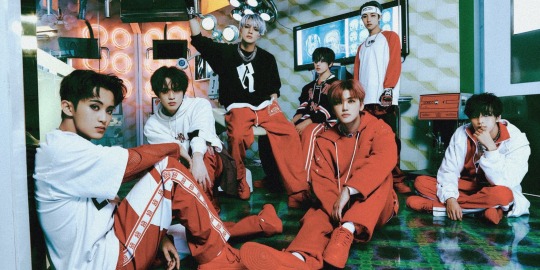

𝐒𝐲𝐧𝐨𝐩𝐬𝐢𝐬: Eight of the top ten most popular players in Korea are invited to be the first people to test out the newest device and gameplay by NEO a video game company known as of recent to be the best of the best. An opportunity of a life time handed to them to be able to trial and get a contract to promote it later on. The eight couldn’t resist as they gladly accepted the invitation. Not being able to predict what was to come. A trail test that wouldn’t just be focused on graphics and playablity, no this would test relationships, strength, resolve and many more unpredictable things.
𝐏𝐚𝐢𝐫𝐢𝐧𝐠: Nct Dream ot7 x Reader
𝐆𝐞𝐧𝐫𝐞: Angst, Fantasy, Fluff, Gaming, Humour, Romance, Smut (in future chapters), Thriller.
𝐖𝐨𝐫𝐝 𝐂𝐨𝐮𝐧𝐭: 1,7k+
𝐖𝐚𝐫𝐧𝐢𝐧𝐠𝐬: None in prologue.
𝐃𝐢𝐬𝐜𝐥𝐚𝐢𝐦𝐞𝐫: This does not depict an accurate picture of Nct Dream and this is strictly fantasy/fiction for entertainment purposes.

“Good morning, welcome to KBS! Today’s first story will interest our younger audience and may just worry all our parents out there.” A well put together broadcast reporter spoke all the while giving the audience watching her through the screen a bright pearly white smile.
“The youth these days seems to be focusing widely on entertainment in the video game area. Well, everyday there seems to be new things coming out but what we have today is something quite extraordinary.” She recited off the teleprompter hidden from sight pointing behind her at the big green screen that showed images and videos to the audience.
“The biggest competitors in gaming in Korea with well known usernames most teens know have all recently been invited to a new project.”
As she spoke on screen were several very well known professional gamers, some showed streaming while others were seen celebrating recently won titles at gaming competitions.
“The project in question is Project Impact. We have all heard of VR, virtual reality but the people at NEO have taken a large step for the gaming community. Unfortunately we don’t have a lot of information on the current project but we will explain what we have.”
“They have worked on a way to make virtual reality more real and as the CEO has promised an experience unlike any other, they have created a way for the player to be able to be in the game with their conscience attached all the while the player is in a sleep-like state.”
As the woman spoke images appeared of people wearing a certain tech wear headgear, seemingly ‘in game’ while their bodies were either laying down or in a sit up position on comfortable chairs.
“The game attached to this new device has also been developed by Neo and is seen to be an in world game with all sorts of challenges and filled with interesting plots. They have confirmed the game is finished.”
“Neo has requested from top players in Korea to test out the tech wear headsets and gameplay, getting many replies and contracts from said players and is due to start testing tonight around 8pm. Though for those interested to see how it plays out, unfortunately it will be under wraps to test out any bugs and glitches at first, but if deemed playable will be streamed and shortly available to the public in only a few months.”
“We have yet to see the whole list of top players that will be testing Neo’s new device and game but those we do have we can list off for you video game enthusiasts, you may just see some of your favourites.”
The reporter, now gesturing at the backdrop once again.
“Mark Lee, also known as Lee Minhyung with the tag name Mork is a Canadian, Korean competitive player known for playing Elden ring, Fortnite and Wow, keeping his place in the top 10 popular Korean players for the sixth year in a row now.”
A video of Mark during his usual streaming was shown with fellow friend Donghyuck, another popular gamer seen in the background screaming his head off at Mark managing to pull his team through for a win.
“Huang Renjun, with the tag name Injeolmi, formally from Jilin ROC now residing in Seoul, SK known very well as a player in Overwatch, King of legend and Fortnite. Placed on the top ten most popular Korean players ranking for the fourth year straight.”
A video of Renjun accepting his award at the most recent gaming event for Overwatch was played also showing a good friend of his, Jeno clapping him on the back for winning.
“Lee Jeno, with the tag name SamoyedJ. Based in Seoul, Sk, another top ten popular Korean player well known for playing Overwatch, King of legend and Valorant.”
A video of Jeno was played from his social media account of his new set up showing off the new branded items he’d received that would help him along. A discord chat with fellow players and friends popped up while he did so.
“Lee Donghyuck, more known by his streaming name Haechan with a gaming tag by the name of Fullsun, holding his top ten most popular Korean gaming title for the fifth year. Known for Valorant, WOW and various odd games.”
A video of Donhyuck appeared of him lounging in his gaming chair animatedly talking with his chat about whatever he had set up for the stream ahead.
“Na Jaemin, with his tag name Nana, another top ten most popular Korean player in his fourth year on the list is well known for Indie games, League of legends and Fortnite.”
Jaemin appeared on screen screaming in terror at another horror indie game playthrough he was doing, camera shaking with him in the dimly lit room.
“Zhong Chenle, also known as Jong Jinrak who goes by the tag name Dolphinlele, formally resided in Shanghai ROC, now currently in Seoul, SK. Having a two year streak being in the top ten most popular Korean players. Known for playing Valorant, Fortnite and Elden ring.”
Chenle was shown on screen one hand moving his mouse clicking around screen with the other arm full with his dog, Daegal sleeping there contently during the stream.
“Park Jisung, with the tag name Jwijwi is based in Seoul, SK a newly added gamer on the top ten most popular Korean players since last year. Mainly known for League of legends, mobile games and Valorant.”
A stream was shown of Jisung sharing food with a friend Y/n on screen as the two spoke to chat while getting ready and picking what two player game to do together.
“The last on the known trail list is L/n F/n, known with the tag T/n, formally based in C/n now residing currently in Seoul, SK, a fresh face this year on the top ten most popular Korean players. Known for Indie games, Cod and Overwatch.”
Y/n was shown on screen playing a game only to be interrupted with a fellow friend and gamer, Donghyuck bursting through the door on screen chasing her cat who went straight towards her desk underneath and between her legs. Y/n scrambling to pause the indie game while Donghyuck whined about her cat not liking him.
Once finished listing off the currently known players entering the trails the reporter pushed aside the small stack of papers on her desk giving the viewers another smile getting ready to say her next rehearsed lines.
“Now I’m sure it’s not needed for me to repeat the list for everyone to have gotten the clue that eight of the top ten most popular Korean players have decided to go through this test trials. Exciting times for their fans I’m sure. These are the current players we know of, the other two most popular gamers could very well have accepted an invitation too but for now we’ll just have to keep our eyes and ears open for any news on that.”
The last photos on screen behind the news anchor was a promotion of the eight players shown wearing similar outfits that were little Easter eggs on previous video games made and produced by NEO to show their official sponsorship with the company.
“We will have more to come on this story later on so stay tuned for that, now onto the weather with my co host who has some exciting news for those who enjoy the warm weather that will surely be quite a good experience for anyone looking to go hiking.”

“Not really sure why we’re wearing outfits for a different old game that has nothing to do with the current game.” Renjun pointed out as he zipped the hood around his face upwards to cover the bottom half of his face.
“Look, we’re matching Junnie, plus who cares this is fun.” Donghyuck nudged his shoulder playfully against Renjun’s, having not zipped his face hood up yet.
“Unfortunately we are.” Renjun grumbled in return harshly zipping up Donghyuck’s zip for him, causing the younger to let out a few muffled complaints.
“Why does Y/n get the grey one?” Chenle whined out his own voice muffled by his knitted mask, hands grabbing and tugging on Y/n’s mask's ears. Her hands flew up to hold onto the mask so it didn’t slip off and ruin anything.
“Let go, it’s not my fault they gave me this character.” Her reply also muffled as she grunted pushing her back into Chenle to make him let go.
“Don’t break it.” Jisung fretted over the duo’s squabble, his hands hanging in the air ready to jump in if needed.
“You look hilarious. Your white hair looks like it’s a part of the mask.” Jaemin teased Jeno pointing at him, holding back a laugh.
“It doesn’t. I’ll smother you right here.” Jeno bit back grabbing onto Jaemin’s mask, tugging it to cover his whole face instead of only half. Jaemin’s muffled screams still loud and clear as his hands flew out blindly slapping at Jeno.
“This is what eight of the top ten most popular Korean players look like, if only people could see us like this our places would be lower.” Mark muttered to himself, his own mask still in hand as he observed his friends' antics.
“Mark! Chenle’s going to rip one of Y/n ear’s off, uh not her real ones the fake ones!” Jisung’s nervous voice cut off Mark’s self monologue as he rushed over to break up the play fight.
“We’ll be taking group photos first before going into individual headshots in two minutes, please be prepared.” The director's voice boomed over to the area the gamers were currently getting their last minute touch ups.
“Two minutes?” A makeup artist asked out in dismay as she and the hairstylist looked over at the eight players who were rough housing.
“Two will be enough to fix up their hair.” The hairstylist spoke reassuring himself since he’d only have to fix the fringes peeking out of their masks.
“How nice for you.” The makeup artist replied to him in dismay, eyeing where Jaemin’s face was currently being messed around underneath his mask.
“You’re right, I’ll ask the director to give us an extra five… ten minutes.” The hairstylist sympathised with his work colleague as he moved away. While the makeup artist rushed over to the eight gamers to do damage control on her previous work hoping she wouldn’t see too many smudges.
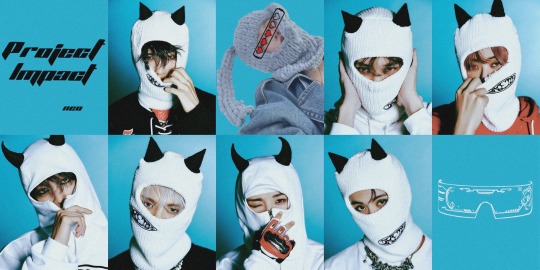
𝐓𝐚𝐠𝐥𝐢𝐬𝐭:
(If you want to be tagged in my Nct Dream writing comment, inbox or message me)
Thank you for reading I hope you enjoyed. Don’t forget likes, reblogs and comments are always encouraged and help keep writers like myself motivated to continue our stories.
𝐏𝐫𝐨𝐣𝐞𝐜𝐭 𝐈𝐦𝐩𝐚𝐜𝐭 𝐌𝐚𝐬𝐭𝐞𝐫𝐥𝐢𝐬𝐭:
⤻ Click here.
𝐌𝐚𝐬𝐭𝐞𝐫𝐥𝐢𝐬𝐭:
⤻ Click here.
#nct dream#mark lee#mark x reader#lee donghyuck#lee haechan#donghyuck x reader#haechan x reader#jaemin x reader#na jaemin#huang renjun#renjun x reader#lee jeno#lee jeno x reader#zhong chenle#chenle x reader#park jisung#jisung x reader#nct dream au#nct dream angst#nct dream fluff#nct dream oneshot#nct dream imagines#nct dream ot7 x reader#poly nct dream#nct dream gaming#nct dream gaming au#nct dream x y/n#nct dream series
50 notes
·
View notes
Text
My Luxury Apartment- General Script
I script this apartment complex in most of my DRs and my Waiting Room. Features like the room style change based on what reality the script is for, but the rest generally stays the same. This is the complex I shifted to the first time, all the things I would’ve enjoyed if I stayed longer.
Exterior: At the back of the complex, there’s a playground with equipment for adults too. The playground equipment can handle adult bodies using it.

Basement level: At the basement level, there are storage lockers for the tenants of the apartment, a parking garage, a shop, and a convenience store. The convenience store carries a brand of microwave dinners that has a wide variety of options, and it includes many cultural dishes from various cultures. For example, one of the frozen dinner sets includes collard greens cooked with smoked ham hocks and black eyes peas, fried catfish, baked mac and cheese, and a little cup of banana pudding or candied yams. The store sells other easy to make food items, such as roux cubes for curry and egusi stew. There is also a laundromat down there, for residents that don’t have personal machines.

First floor: The first floor has the lobby of the apartment building, an indoor pool and hot tub for the residents and their guests, and a hot pot restaurant. Residents get a discount at the restaurant, but it’s open to the public. It also has a gym that holds exercise, dance, and yoga classes.
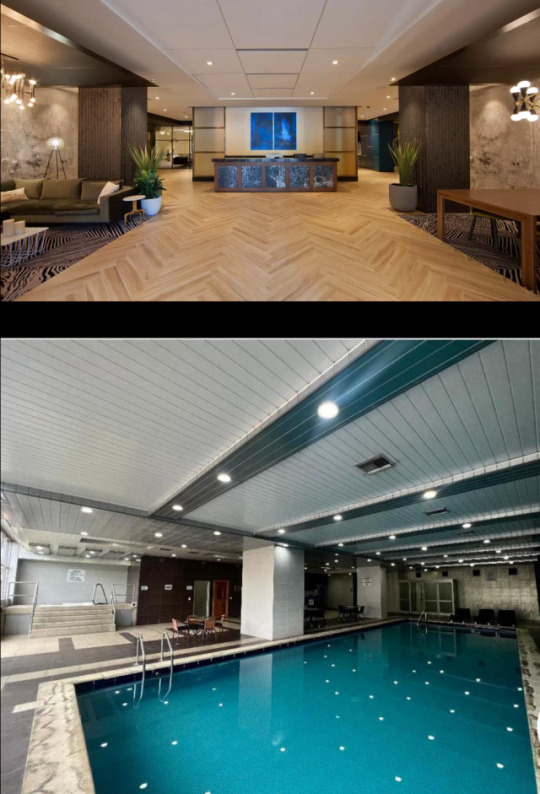

Second floor: There’s a small doctor’s clinic on this floor, staffed by several nurses, two pediatricians, a mental health counselor, and a few physicians. Here, residents (and our guests) can receive regular checkups, emergency aid, help with medical treatments such as dialysis, etc. Attached to the clinic is a small pharmacy where you can get cold medicines, common emergency medicines like epipens and inhalers, etc. There’s also a daycare on the other side of the building, and between them is the complex spa. The spa has masseurs trained in neuromuscular massage therapy.


Third floor: A work space with computers for public use, recreational room that doubles as a movie theater with a larger screen, and an additional rec room with video game consoles, VR gaming space, and a small cafe. The first rec room is popular with older residents, while the second is more popular with the teenage residents.
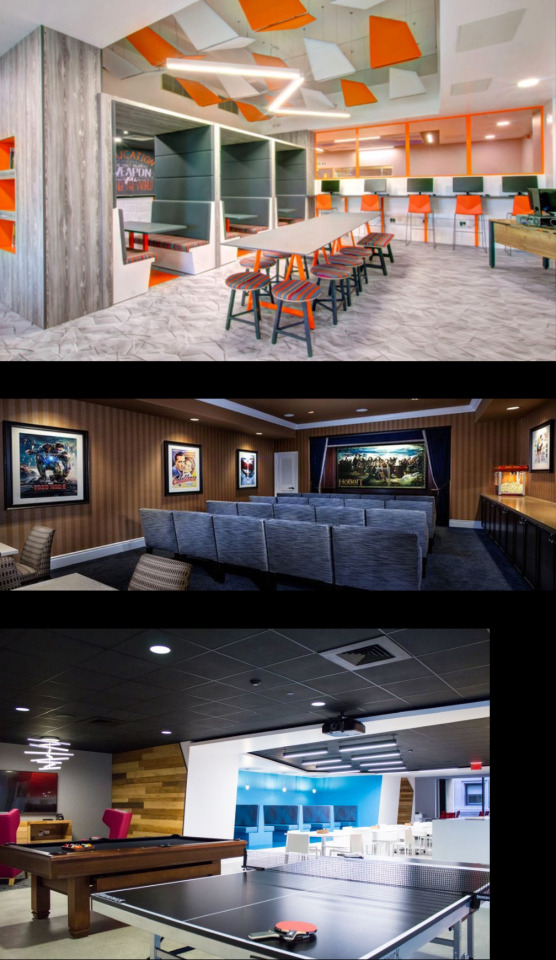
Penthouse: My penthouse apartment also has a balcony with seating, two guest bedrooms each with its own 3/4 bathroom, and a walk-in storage closet.
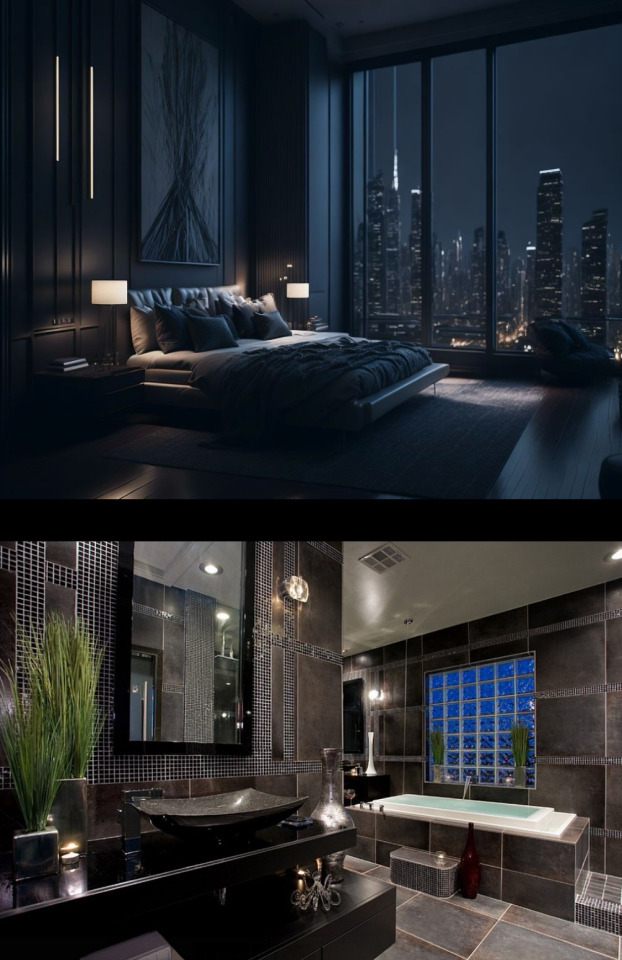

Rooftop: On top of the apartment complex is a community garden and an observatory. There are gardeners that maintain most of the plots, but private plots must be privately managed.

Safety features: Along with normal safety features, all the windows and doors on the first and second floor, plus parking garage, have metal shutters that can be lowered during emergencies. The entire building also has an advanced fire suppression system, air purifiers, and an extensive bunker below the parking garage. Each apartment, or at least the penthouses, have security doors (thick wooden doors with metal plates in the middle and higher quality locks). All the safety features have their own failsafes.
#reality shifting#shiftblr#shifting realities#desired reality#shifting community#shifting reality#shifting script#black shifters#quantum jumping#shifting#reality shifter#shifting blog#reality shift#shifter#shifters#shifting motivation#my dr#my script#shifttok#dr tidbits#realityshifting#long reads
25 notes
·
View notes
Text
Hire a Mobile App Development Company in India Today
Looking for high-quality mobile app development at affordable prices? You’ve come to the right place. At Mobulous Technologies, we help startups, enterprises, and entrepreneurs turn their app ideas into stunning reality.
Why Choose India for Mobile App Development?
Access to the best Indian app developers for hire
Cost-effective pricing without compromising on quality
Skilled teams in Flutter app development, React Native, Android, and iOS
Seamless communication and project management
End-to-end solutions: UI/UX mobile app design to deployment
What We Offer
Custom Mobile App Development India
Cross-Platform App Development (Flutter, React Native)
On-Demand Mobile Apps
Android and iOS App Development Company India
Full-stack App Development Services India
Technologies We Work With
We combine the latest technologies to build modern, user-centric mobile application solutions:
Flutter App Development
React Native Developers
Swift, Kotlin, Node.js, Firebase
Figma, Adobe XD for UI/UX
AI, Blockchain, IoT, AR/VR integrations
Why Hire Us?
Recognized among the top mobile app development companies India
500+ apps delivered across industries
ISO certified process, 100% NDA-secure
Dedicated project manager & on-time delivery
Trusted by global brands and startups alike
Affordable Mobile App Development in India
We offer flexible engagement models to suit all business sizes. Whether you’re building an MVP or a fully customized solution, our pricing fits your budget.
App Type with Estimated Cost (USD)
Basic App: $5,000 – $10,000
Mid-Level App: $10,000 – $30,000
High-End Custom App: $30,000+
How to Get Started
Step 1: Share your idea with us
Step 2: Get a detailed proposal with timeline and cost
Step 3: We build your app with frequent updates
Step 4: Launch your product and scale your business
Let’s Build Your App Together
Ready to build your dream app with the help of top-tier mobile app developers in India? Let Mobulous Technologies help you every step of the way.
Also Read This: https://sites.google.com/view/hiremobileappdevelope/10-reasons-you-should-hire-a-mobile-app-development-company-in-india-today
#mobile app development services in India#custom app development India#mobile app developers India#affordable app development India#Android app development#iOS app development#app development outsourcing#app development team India
2 notes
·
View notes